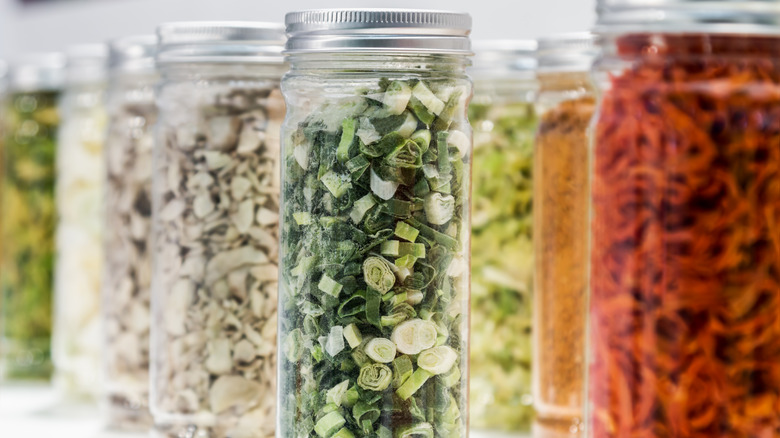Freeze-Dried Vegetables Can Last Nearly A Decade — But Do They Stay Nutritious?
If you're a hiker or a camper (or an astronaut) you may be familiar with freeze-dried food. The popular preservation technique of freeze-drying helps to extend the shelf life of food to make it easier for people to keep it and transport it since it doesn't require refrigeration. In fact, some freeze-dried vegetables can last for eight years or more.
As food ages, though, its quality can deteriorate (as evidenced by that mushy bag of salad greens in your crisper that you once swore you would eat). Some preservation methods, like canning, are useful for helping to retain nutrients in food. Others, like dehydration, are less successful, with the heat from the process contributing to a loss of up to 40% of the food's original nutrients.
While dehydrated foods are sometimes confused with freeze-dried, their nutritional values can be vastly different. Thanks to the freezing part of the process, an eight-year-old bag of freeze-dried peas, mushrooms, or kale is still nearly as nutritious as when the veggies were picked.
Benefits of freeze-dried food
Freeze-dried foods can retain up to 90% of their original nutrients. Multiple studies cited by the National Institutes of Health indicate that freeze-drying is superior to other drying methods for helping foods to retain antioxidants and vitamins.
Another healthy upside to freeze-dried foods is that they are preserved naturally through the freeze-drying process, so there's no need for preservatives to be added. There's also no additional sugar or other additives.
In addition to retaining nutrients, the freeze-drying process also helps to keep foods consistent with their fresh counterparts in terms of texture and flavor and they're more likely to look similar to their fresh version than dehydrated food. This all contributes to freeze-dried food being more palatable and appealing.
And, of course, freeze-dried food offers the benefit of its extraordinarily long shelf life, which means that whether you're an avid adventurist looking for nutritious snacks or meals to carry on your trips, or you're just looking to stock up, freeze-dried vegetables can be a healthy option.
Where to find freeze-dried food and how to use it
Freeze-dried foods can be found at most of your favorite brick-and-mortar stores from Trader Joe's to Target. There are also a number of specialty retailers online to buy from, too.
While the upfront costs can sometimes be relatively expensive, you can also purchase your own freeze dryer to preserve food at home. In addition to vegetables, you can freeze-dry fruits, cooked meats, grains, drinks, spices, and even full meals.
While freeze-drying is practical for preservation purposes, there are also other practical uses for freeze-dried food that can elevate your cooking and baking. Chef David Chang, of Momofuku, suggests using freeze-dried chicken and mushrooms to create a stock that's rich and flavorful.
Meanwhile, queen of the home kitchen Martha Stewart swaps out food dye for freeze-dried fruit to color her baked goods. Her Instagram account features cookies and cake colored with ground freeze-dried berries.
Whether you choose to get fancy with your freeze-dried food or use it to sustain you on a long camping trip, you can rest assured that those years-old veggies are still chock full of vitamins.


